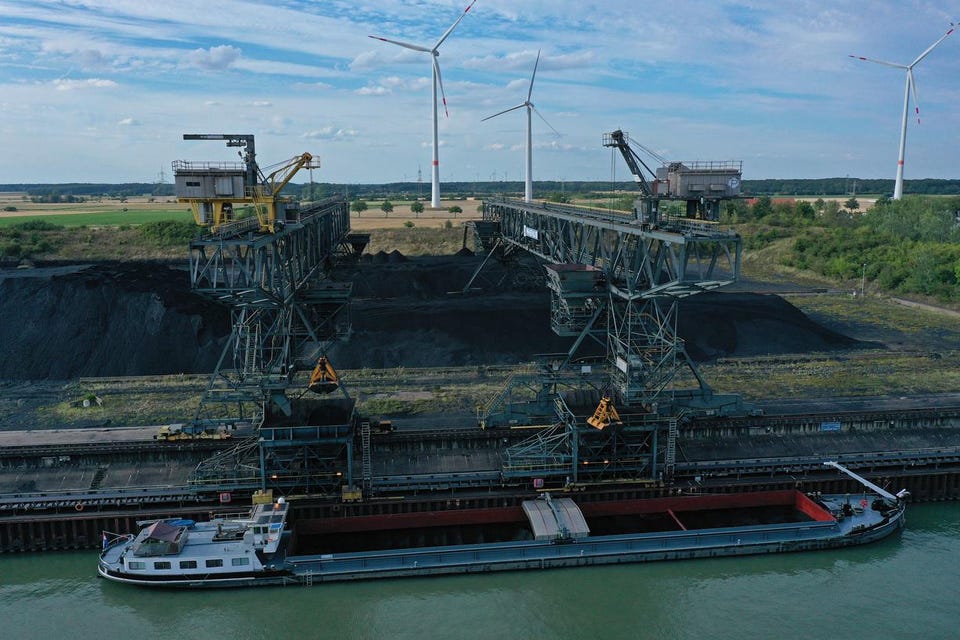Energy Global Coal Consumption Surged In 2021 Robert Rapier Senior Contributor Opinions expressed by Forbes Contributors are their own. New! Follow this author to stay notified about their latest stories. Got it! Aug 9, 2022, 06:00am EDT | New! Click on the conversation bubble to join the conversation Got it! Share to Facebook Share to Twitter Share to Linkedin PEINE, GERMANY – AUGUST 03: In this aerial view machines unload coal from a barge destined for the .
. . [+] nearby coal-fired Kraftwerk Mehrum power station on August 03, 2022 near Peine, Germany.
The Mehrum plant, after lying idle since last December as part of Germany’s effort to reduce its use of coal in favour of renewable energy sources, fired back up on July 31 as part of the German government’s efforts to reduce electricity production with natural gas imported from Russia. The German government, in a bid to raise its reserves of natural gas ahead of the coming winter, is turning to coal among alternatives for electricity production. Germany produces approximately 15% of its electricity with natural gas and is seeking to reduce its consumption due to ongoing tensions with Russia, from which it still imports large quantities of gas.
Russia has reduced gas flows to Germany as a consequence of Germany’s support for Ukraine against Russia’s ongoing military invasion. The Mehrum station belongs to Czech energy company EPH. (Photo by Sean Gallup/Getty Images) Getty Images This article is the fifth in a series on the BP Statistical Review of World Energy 2022 .
The Review provides a comprehensive picture of supply and demand for major energy sources on a country-level basis. Previous articles covered overall energy consumption , carbon dioxide emissions , petroleum supply and demand, and global natural gas trends . Today I delve into the data on coal production and consumption.
Comparing Coal’s Emissions Coal is the most polluting fossil fuel. What is meant by that? Fossil fuels are primarily composed of carbon and hydrogen. They are hydrocarbons.
When hydrocarbons are combusted, the carbon forms carbon dioxide and the hydrogen forms water vapor. Coal contains a higher percentage of carbon than does oil or natural gas. So, when coal is combusted, it generates more carbon dioxide per unit of energy than oil or natural gas will generate.
According to the Energy Information Administration (EIA), combustion of coal emits about 210 pounds of CO 2 per million British thermal units (BTU) of energy. In comparison, oil emits about 160 pounds of CO 2 per million BTU, and natural gas emits 117 pounds of CO 2 per million BTU. Coal also produces a lot of other harmful emissions when burned in power plants.
Historically, coal plants emitted a lot of sulfur dioxide, which causes acid rain. Regulations eventually reined in that problem, but coal-fired power plants still emit pollutants like mercury. They even emit more radioactive elements into the environment than a nuclear power plant.
Thus, there have been many regulations passed that have attempted to lower coal’s impact on the environment. MORE FOR YOU Here’s The List Of 317 Wind Energy Rejections The Sierra Club Doesn’t Want You To See Revisiting The Blame For High Gas Prices Why Do ‘Fracking’ Opponents Ignore Its Moral Benefits? Because of the various pollution issues associated with coal, most developed countries have moved away from coal-fired power. But because coal is cheap, developing countries continue to rely heavily on coal as a source of power.
Coal consumption in developing countries is presently the largest global driver of rising carbon dioxide emissions. 2021 Consumption and Production Statistics As a result of the Covid-19 pandemic, 2020 saw a record 4. 2% drop in global coal consumption.
Within the 38 countries that comprise the Organisation for Economic Cooperation and Development (OECD), coal consumption fell in 2020 by 15. 2%. However, as with oil and natural gas, coal consumption bounced back strongly in 2021, growing by 6.
3%. Coal consumption in non-OECD countries rose to a new record, while global coal consumption fell just short of the previous record set in 2014. Non-OECD countries now consume 81.
5% of the world’s coal. Global coal consumption 1965-2021 Robert Rapier Six of the world’s ten largest consumers of coal are in the Asia Pacific region. All but one of last year’s Top 10 consumers saw an increase in coal consumption from 2020.
Below were the world’s Top 10 coal consumers in 2021. “Change” refers to the growth or decline from the previous year. Top 10 coal consumers in 2021 Robert Rapier Germany, which has been phasing out nuclear power and aggressively pursuing renewables, had the largest percentage increase in coal consumption from the previous year (among the Top 10 consumers).
Coal producers are geographically more diverse than coal consumers. Nevertheless, China dominates the world’s coal consumption and production. Below were the world’s Top 10 coal producers in 2021: Top 10 coal producers in 2021 Robert Rapier The coal industry in the U.
S. has seen both supply and demand steadily declining for 15 years. The dramatic decline in U.
S. coal consumption is the primary reason U. S.
CO 2 emissions have fallen sharply in the past decade. Coal consumption in power plants was displaced by cheaper natural gas and renewables, both of which have a much lower carbon footprint. However, that downward trend reversed direction in 2021, which saw a surge in both coal production and consumption in the U.
S. In the next installment, I will take a closer look at global renewable energy trends. Follow me on Twitter or LinkedIn .
Check out my website or some of my other work here . Robert Rapier Editorial Standards Print Reprints & Permissions.
From: forbes
URL: https://www.forbes.com/sites/rrapier/2022/08/09/global-coal-consumption-surged-in-2021/



